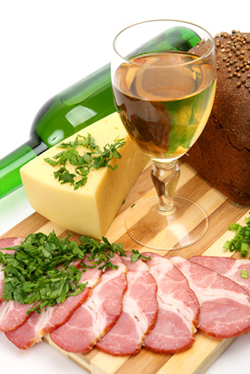Wine & Food
German wines are the lightest wines produced - they are both lower in alcohol and calories - making them suitable for a large variety of dishes. Although there is no specific rule in selecting a wine for a meal, we provide below some recommendations and guidelines for selecting a wine.
Quick links to wine recommendations:
General Dishes
| Style of Dish |
Wine Recommendation |
Light and mild
|
Dry to medium-dry, white Kabinett wine (such as Riesling, Müller-Thurgau, Weissburgunder, Grauburgunder ) |
Light and spicy
|
Dry to medium-dry, white Kabinett wine (such as Müller-Thurgau, Grauburgunder, Scheurebe); Rosè or light red wine (such as Spätburgunder, Schwarzriesling) |
Hearty but mild in taste
|
Dry to medium-dry white wine and Spätlese (such as Weissburgunder, Grauburgunder); Dry, ripe Riesling Auslese; Smooth, mild rosè wine or a light red wine (such as Spätburgunder) |
Hearty and spicy
|
Dry to medium-dry white and red wine, Spätlese and Auslese (such as Weissburgunder, Grauburgunder, Gewürztraminer, Spätburgunder) |
Wine & Chocolate
| Chocolate |
Wine Recommendation |
| Milk Chocolate |
Sweet Auslese and Beerenauslese Riesling wines; Fruity, spicy red wines |
| Semi-Sweet or Bitter Sweet Chocolate |
Dry, full-bodied red wine |
| Chocolate containing hazelnuts or almonds |
Sweet white wine; Dense, full-bodied red wine |
Wine & Cheese
There are 6 guidelines to follow to pick the best wine for cheese.
| 1. |
The creamier the cheese, the more acidic the wine can be. |
| 2. |
Acidic cheese fits best to medium-dry to sweet wines. |
| 3. |
Combine salty cheese with sweet wines - try also an acidic wine. |
| 4. |
For cheese platters with a variety of cheeses, select a wine that would fit to the strongest tasting cheese. |
| 5. |
Pair wines and cheese from the same region. |
| 6. |
Tastes of the cheese and wine should not be the same. For example, sour cheese should be paired with sweet wine. |
| Cheese |
Wine Recommendation |
| Soft Cheese with Flowery Rind (such as Brie or Camembert) |
Dry to medium-dry Riesling; Young, fresh Grauburgunder; Spätburgunder |
| Soft Cheese with Washed Rind (such as Limberger, Munster) |
Dry Riesling or Gewürztraminer |
Fresh, Unripened Cheese (such as Quark, Cottage Cheese, fresh Mozerella)
|
Light, lively Weissburgunder; Spätburgunder |
Blue Vein Cheese (such as Roquefort, Gorgonzola)
|
Auslese, Beerenauslese |
Goat's Milk Cheese
|
Dry to fruity Riesling or Weissburgunder |
| Semi-hard to hard, sliced Cheese (such as Edamer, Gouda, Butterkäse) |
Medium-dry Riesling wine for young, mild cheese; Gewürztraminer for stronger cheese varieties; Light Spätburgunder |
Extra Hard Cheese (such as Emmentaler, Gruyère, Parmesan, Cheddar)
|
Riesling or Scheurebe Auslese |
|

Photo: © tigera - Fotolia.com

| Picking the perfect wine for a meal is something that many people feel unsure about. Below we provide some guidelines with the goal of creating a harmony between food and wine. |
| |
| Guideline #1 - Trust your own taste |
| Anyone who has had a glass of wine with a meal already knows his or her taste preference. If this is you, don't second guess your preference if it is right or wrong. If you like a particular wine and food combination, then enjoy it. If having guests over, don't rely completely on your own preference. |
| |
| Guideline #2 - Follow the season |
| What applies to foods, applies also to wines: they fit better to one season or another. Heavy red wines fits better to late autumn and winter times when its cold outside. A light, fruity wine fits better to summer. |
| |
Guideline #3 - Sour + Sour =
Sour x 2 |
| A sourness from both wine and food multiplies. This means that combining a sour, dry wine with a sour, acidic dish creates an overwhelming sourness. Also, a dry or medium dry wine does not go well with a sweet dessert. For dessert, its best to stick with a Beerenauslese or Eiswein. |
| |
| Guideline #4 - Spicy food with fruity wine |
| For spicy Asian foods, select an aromatic fruity wine, such as a Gewurztraminer or Riesling. |
| |
| Guideline #5 - Everything's possible with meat |
| The old rule - pair red meat and roasts with red wine / pair poultry and fish with white wine - works fine, but don't be limited to this. One must also take into consideration how the meat was prepared. For example, grilled chicken or fish go very well with a red wine. Boiled or stewed beef or pork goes very well with the acidity from a white wine. |
| |
| Guideline #6 - Don't cook with a cheap wine |
| When cooking with wine, be sure to select a wine of good quality and taste otherwise your food will taste of bad wine. |
| |
| Guideline #7 - Some advanced tips |
| • |
To emphasize the sweetness or spiciness of a meal, select a wine with a higher alcohol content. |
| • |
Pair dishes, with bitter undertones, with sweet wines to soften the bitterness. |
| • |
Heavy, rich meals pair well with acidic, alcohol-rich wines. |
| • |
Sparkling wines taste sweeter when paired with meals due to the carbonation. |
|
| |

Photo: © Brenda Carson - Fotolia.com
|

